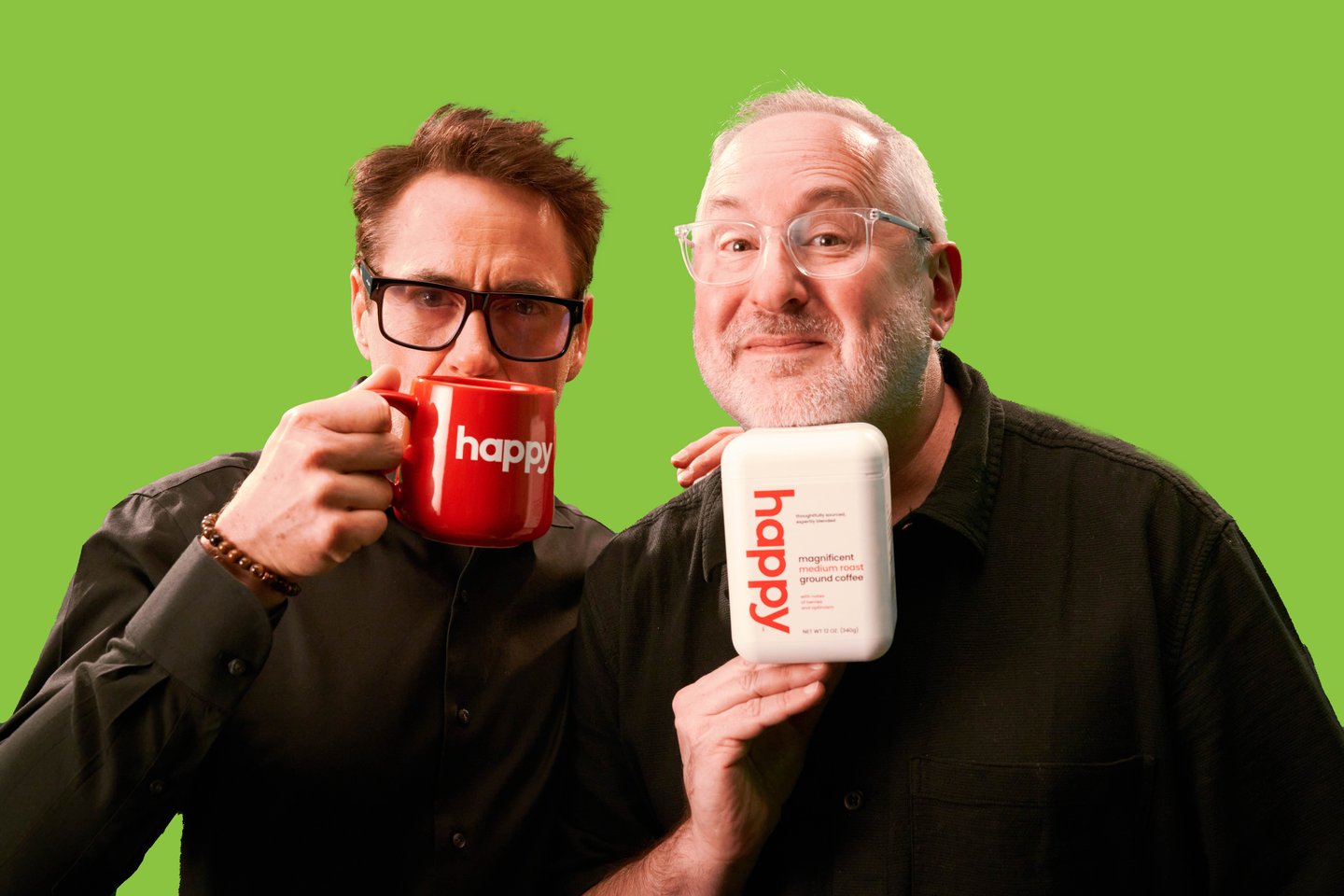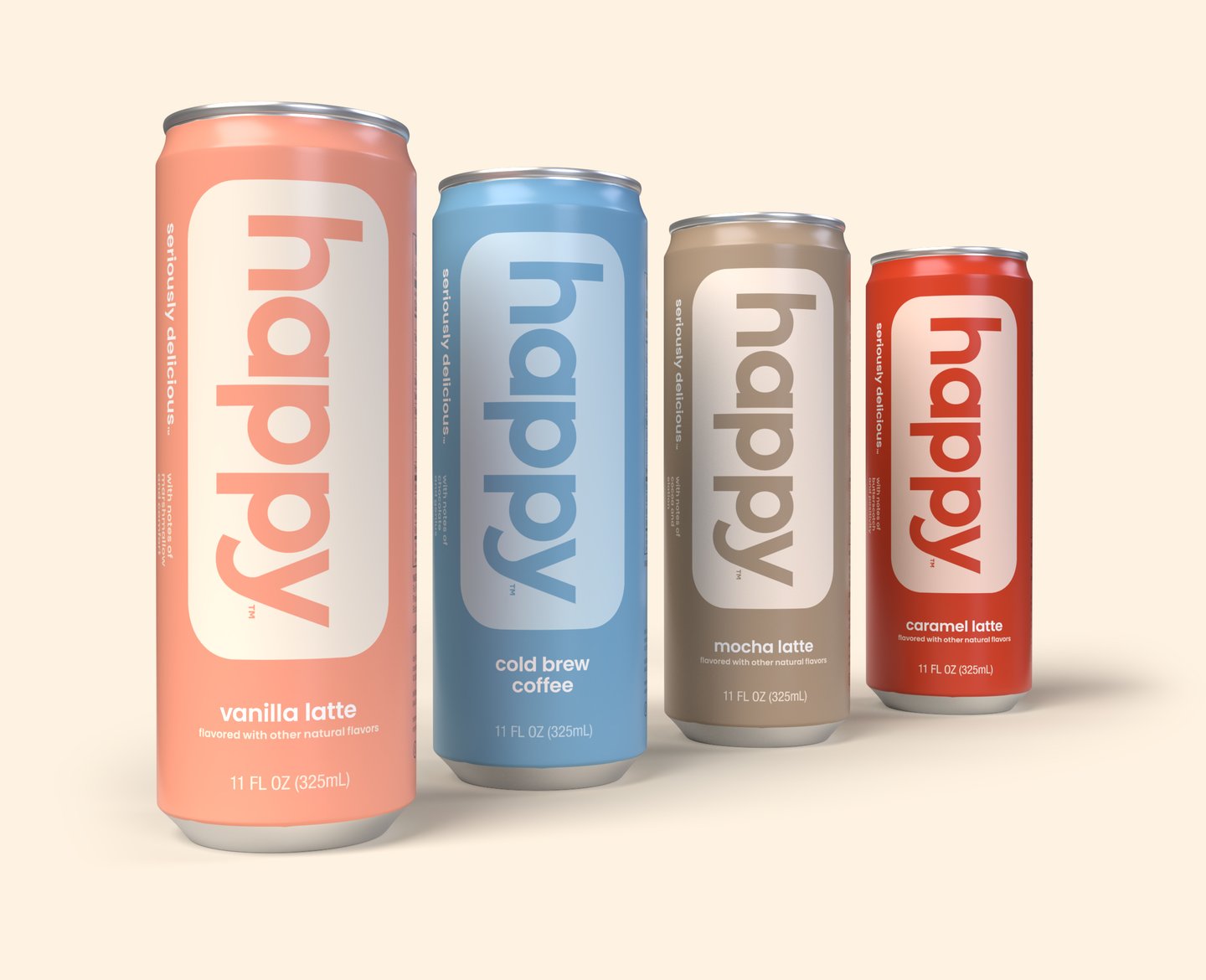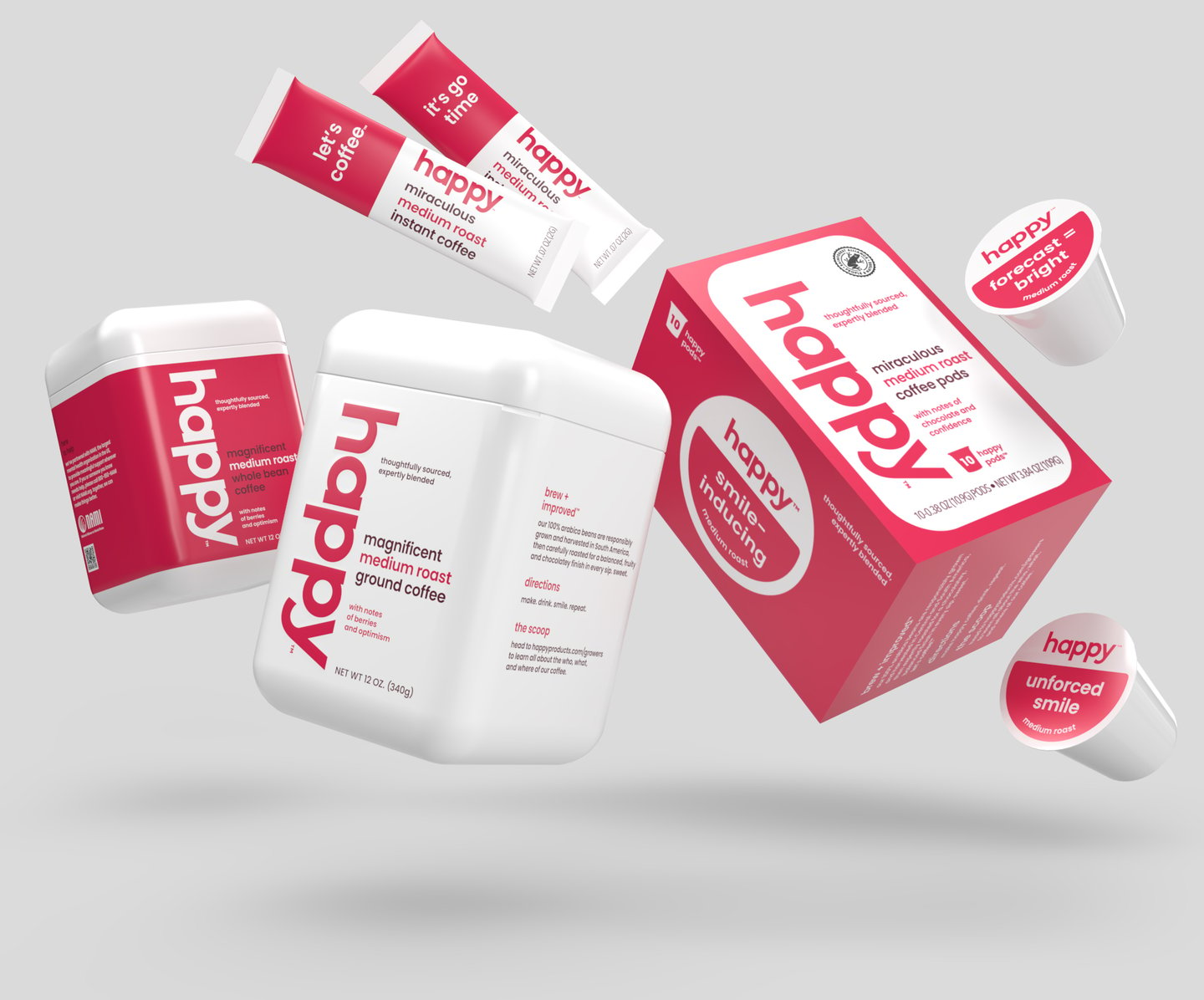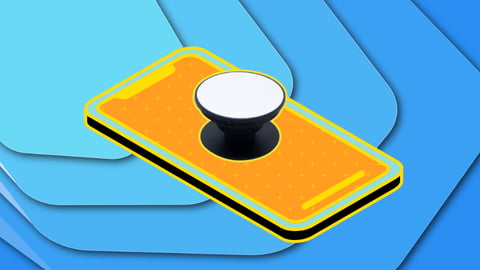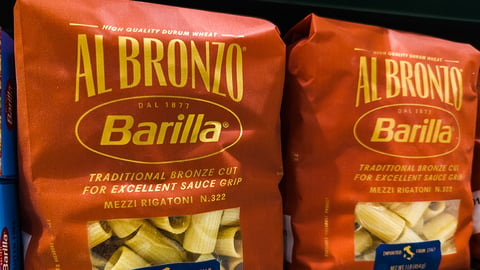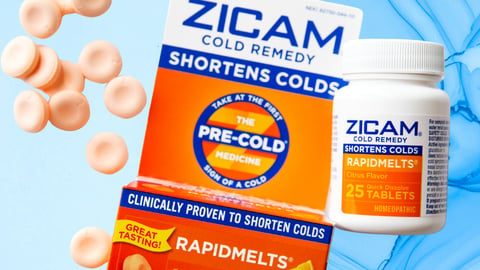How Happy Products Is Marrying Magic With Rigor for Startup Success
With a retail presence that’s younger than some beverage shelf lives, Happy Products finds itself in an enviable position.
Co-founded by CPG marketing and startup veteran Craig Dubitsky, Happy’s coffee products are now available through more than 10,000 retail stores, Amazon, Target and Walmart dot-coms, and its own direct-to-consumer site after launching at the beginning of this year.
Like many startups, the company is small, with just a dozen employees based out of Dubitsky’s home in Montclair, N.J. (“Happy House”). In addition to priding itself on high-quality products and packaging, it’s also fiercely motivated by its partnership with the National Alliance on Mental Illness (NAMI) organization to help increase free access to assistance without stigma. Product packaging features NAMI’s help line, as well as a QR code leading to additional mental health resources, and Happy has provided NAMI with an equity stake in the company.
Unlike most startups, it also has another well-known co-founder, actor Robert Downey Jr., who often receives the bulk of the headlines. It’s Dubitsky’s CPG roots, however, that span Colgate-Palmolive, Hello Products, Popcorn Indiana, and Eos, among others.
In this latest venture, CGT chatted with him to learn how he’s currently navigating two eternal CPG questions: How do you marry startup magic with the foundation to scale? And what do you bring to the table for your retail partners that’s a little special? (The conversation has been condensed and edited for clarity.)
Congratulations on your Webby Award! [The company’s #happymonday social campaign was named a People’s Voice Winner.]
Thank you. It's very exciting. We’re so new.
The other members of your team must be equally excited.
We're really fired up. We have so much good stuff. We actually just had some fun swag that showed up today in the office, and everyone in the office is just buzzing without any caffeine yet. Energy is very high.
You came to market with the products during a time when consumers are looking for more better-for-you products, whether it makes them feel better about themselves or feel better physically. How do you see Happy aligning with that trend?
I would be remiss if I just said, “Oh, yeah, we had it all planned. We knew what the cultural climate was going to look like at this particular moment.” I don't want to overstate anything, but we feel very fortunate that as a business we're able to bring something to market that we think people are going to fall in love with, at a time where, let's face it, happiness is not exactly at an all-time high.
The plan was really just to focus on making a terrific set of products and making them available to as many people as we could, in the hopes that the products themselves would make people at least a little bit happier.
The fact that we're in this interesting sort of cultural nadir of happiness, and hopefully we can get it to a zenith, is really what's getting us excited. So I think it's a sad thing to say our timing was great because people aren't that happy. We're trying to stimulate more happiness, not capitalize on happiness is probably the best way I can put it.
You have an interesting background in that you have a lot of experience in both the large legacy global CPGs and also the smaller startups. There’s plenty of differences between the two, but where are you finding commonalities?
The dirty little secret is most startups, most small companies, wish they were big companies. No one starts out and says, “Oh, I wish we didn't grow and we didn't have more people join us, more awareness, more infrastructure.”
The other part of the equation is that a lot of larger companies wish they could behave like small companies — that they didn't have legacy and layers. So we're in this really fortunate spot to have the history with some big global CPG companies and with startups, and what they have in common overall is passion.
The passion of the people [at Colgate] is incredible. In talking about just how energized we are over here — it’s the same thing. I think the mechanisms by which we can translate that passion into product, experience, [and] purpose are different. But the shared stuff is there: the love of business in general, the love of team building, the love of brand and storytelling. It's equal for sure.
I feel fortunate to have straddled both those worlds and appreciate the common bits. I’m figuring out how to cherry-pick the best stuff from big, corporate legacy players and from the startups and apply that to what we're doing: team building, focus, deliverables, measurement.
A lot of startups just sort of say, “This feels good. Let’s just do it.” And sometimes part of that is certainly magic and fantastic, and we don't try to squelch that. But bringing some rigor to that magic at the same time has really helped us grow very quickly.
Most large companies do want to, in some way, operate like a startup, and part of that is because of the agility and having less red tape. As you help Happy grow, how are you trying to retain that agility?
I like to say we move at the speed of thought. So if we have an idea, there's no layers or no legacy that get in the way that says, “Wait, that's not how it's done around here.” It's removing all those roadblocks, whether they’re physical in some cases [like with an office].
Moving away from the traditional has helped us move much faster. Not having someone say, “Well, no, we looked at the brand book for 20 years ago, and we have to use a semicolon there and not a colon.” We can change that on the fly if we want. We don't have to go through a whole bunch of layers and directors and managing directors and executives and VPs and everything else.
Now, let's try to back up our feelings with conscientious editing and research, but quick, down-and-dirty stuff.
You do have a quite well-known co-founder, and that’s obviously going to help with your consumer awareness. But what can you tell us about how you're communicating and collaborating with your retail partners? What's really important to them right now? Because I'm sure they're interested in that, but are things approached a bit differently
Robert and I actually were with a bunch of different retail partners as recently as last week. We make it very clear that this isn't a celebrity side project — that we're building a company and we're building a brand, and Robert and I are building the company and the brand together. It's not a flight of fancy for him. Robert and I've been working on this now for a few years. We’re not winging it. We're spending a lot of time talking about strategy, brand, copywriting, positioning, how we engage retail partners.
What we hear from our retailers is they want to enter very firmly into the digital zeitgeist as much as they are part of the physical community. Proximity plays a big part of [where consumers shop], but there's a real interest in figuring out how to use social, [and] how content can play a role and help get another closer location, which is to the heart and the head. As important as it is to have that physical proximity, to have this emotional proximity and relevance is really key.
So I think what they're looking for is new ways to communicate: “Robert, you have 100 million-plus followers across different platforms. Are there things we could do with this brand that we haven't been able to do, or haven't thought about doing, or don't have a willingness from those brand stakeholders to do with us?”
There's usually very strict ways brands behave at larger companies, and we’re able to be very flexible and speedy. The vibe I'm getting from retailers is content creation, community building, awareness. It's about cultural, emotional, and economic relevance.
The other thing we're hearing is [about price]: “My audience, my shopper, can actually afford this stuff, and it's making my shelf look really good because it's pretty and it's recyclable.”
It’s helping them tell other stories through the products that they're making available to their shopper, and to be part of that and find yourself in a position where we can talk to retailers a little differently and say, “Hey, how do we co-create together?” Again, we can do that because we can move really quickly.
I'm not trying to speak on behalf of all of retail — that would be inappropriate of me — but it feels like the idea that we can partner with them in ways that are a little bit different, where it's not just transactional, is a big advantage for us, and something that's exciting for our retail partners.
You mentioned earlier about the importance of bringing measurement and a little rigor to a startup organization. What are some of the metrics that you are using to measure success, beyond revenue?
A big one for us right now is ACV distribution. We put a lot of energy and effort into the formulation of the actual products and a lot of work into the design and the visual vocabulary of the brand, so being able to get product into as many doors as possible is a really important metric for us.
And we're very excited because we should have [in June] about 50% ACV with our dry coffee products, which, given that we just unveiled the brand on January 30, is unbelievable.
It's an important metric for us because we know what margins look like. We know what margin enhancement looks like. We know what margin looks like for our retail partners. We have a sense of what our awareness levels are starting to look like based on some of the marketing we've just started to kick in. It's all trending. It’s great. But if you market and your awareness goes up but people can't find your product, that's not good ROI.
For us — and this is an old adage and isn't anything you haven't heard before — the best marketing is a great product. So how do we make sure we get this great product in front of as many people as possible in a curated way?
What I think a lot of startups and newer brands that are so focused on all things digital sometimes lose sight of is that stores are curated. The infinite aisle of the Internet is fascinating, fabulous, and you have to hope the algorithm does its thing — or you have to spend a lot of money to hope you can manipulate the algorithm to make sure you are tracked and coded and served up and added in a certain way. Things become very expensive.
If you're in a 4-foot set, 8-foot set, 12-foot set — whatever the size may be — you're one of a small handful of offerings. So making sure your product looks beautiful and it actually comes through with the goods that someone will buy more than once is really important.
We've been hyper-focused on distribution right now because we feel like we've nailed a lot of the other bits: great product, great packaging, great experience with the product itself. Now it's time to make sure as many people as possible can not only see it in person and touch it, but afford to get it and convert.
What's the culture like on the Happy team? I know you're small, but you're growing.
We're tiny. That's part of the magic. I'm very fortunate a big part of the team has worked together very closely at the start of Hello. A lot of the founding team from Hello has joined me with this endeavor, and then we brought onboard some additional folks, many of whom I've also known for a long time.
One of the things that binds us all is we love a challenge, and really having a sense for aesthetic and delicacy and very measured and considered design approaches. So whether it's the final shape of the Y in Happy so it doesn't get too kitschy. We touched everything — the UPC codes are touched. We spend a lot of time on all these little design touches, and it's because we have a fondness for design. We're really deep in looking at things through a lens of approachable beauty, so we're bringing that to everything. It’s making little things, little moments that people can fall in love with.
So that's what I think sort of brought the team together, and then a lot of passion around this notion of what we're trying to talk about with respect to awareness around the importance of mental health. It's not a competition, but we think we're playing in this realm with responsibility, which is sort of a new level in terms of mission and purpose because so many people are affected by mental health.
And that's the one thing that has blown me away since starting this is that every day I've heard from somebody that I know, or a complete stranger, who tells me about a personal tragedy, all around mental health. And that has really, truly had a very deep impact on me personally and professionally, and it fires us up because we've got this amazing partnership with NAMI. We feel if we can get one iota more of awareness or give anybody this glimmer of hope that there's a phone number, a QR code, a website — if one more person gets help, it's a huge win. So that keeps us really grounded and excited at the same time.
You're certainly not brand new to this industry, but you're on a new venture. Have there been any unexpected learnings that you've gone through?
The unexpected thing is that I did not think that every day I would hear from someone regarding a mental health-related experience or issue in their life. That has completely and deeply affected me. So that's really what surprised me.
Business-wise, not really. Things always come up. That's life, and we operate in real time all the time. So even when things come up, it’s problem-solution, problem-solution. I haven't seen a problem yet where it was something we’d never seen before. And I hope I don't!
We're feeling confident. The good kind of confident — not cocky. We're feeling like we're buttoned up. We over-invested in all the infrastructure that we need to grow properly, and that's based on just the years of experience and not having built things up properly before.
Last one: What’s next for Happy?
Well, we’re Happy Products, not Happy Coffee. We think Happy as a platform is a bigger idea than just this one category and one product. We're very excited to be in the coffee space and to tackle all aspects of coffee because coffee does make so many people happy. That's why coffee is so important to us — because it's so important to so many people.
So we're starting there. We're deeply focused on all things related to it. Are there things still in the coffee space that we haven't done? 100%. We just launched RTD products and they’re sold out on our website.
[Credit for all images: Happy Products]




